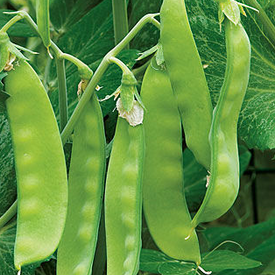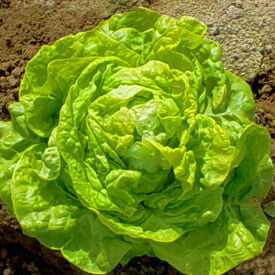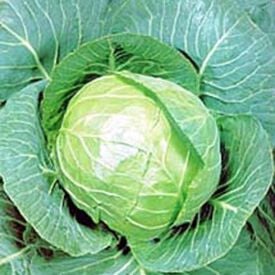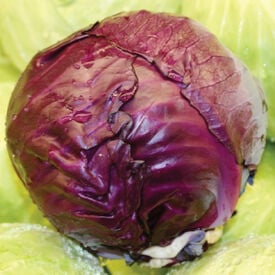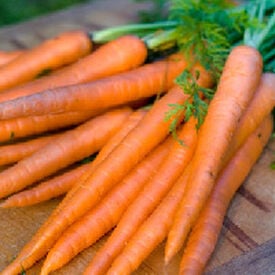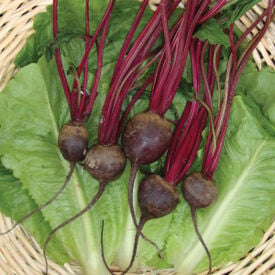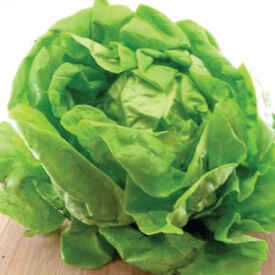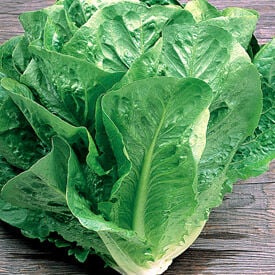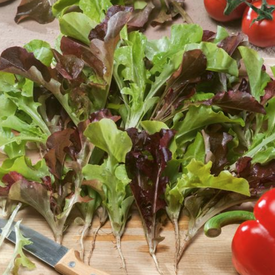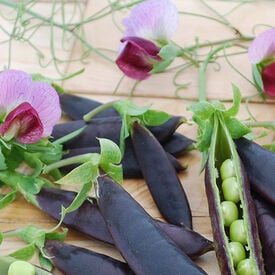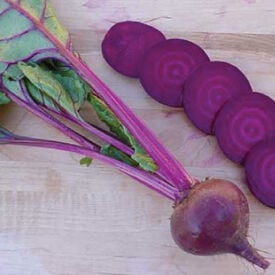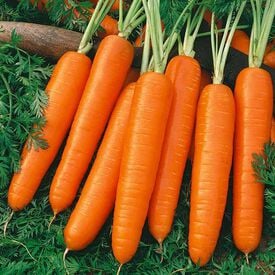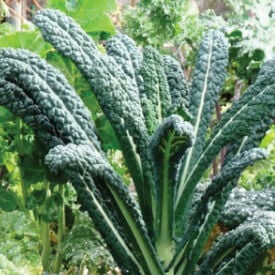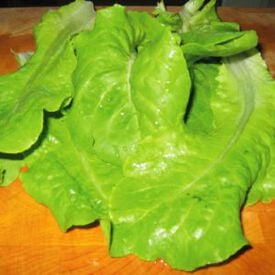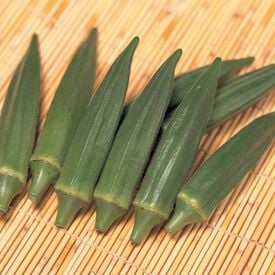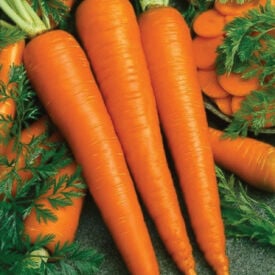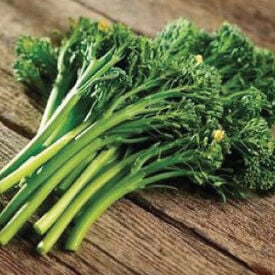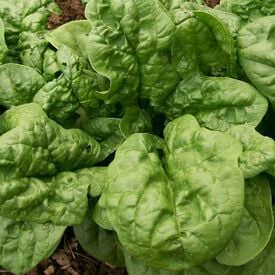The Oregon Sugar Pod II Pea is a high yielding snow pea that has a high percentage of two pods per cluster! This variety grows to a height of 28" and bears 4 1/2" long pods that are disease resistant to pea virus, common wilt and powdery mildew. The Oregon Sugar Pod II produces delicious flat and tender pea pods that are superb for freezing!
The White Boston is a butterhead lettuce that is an improved Big Boston. This variety gives excellent yields of firm, round, 12" heads of crisp lettuce. The White Boston is a very delicious lettuce that is a bright light green with a buttery-yellow heart . This lettuce does well in warm conditions and is recommended for southern gardens.
The Golden Acre is a tasty cabbage that arrives early and is suited for close spacing. This early round head cabbage is easily grown and versatile in use. Heads are about 6 to 7 inches in diameter on compact plants about a foot high. Its firm, medium green head is excellent cooked or raw in stews and salads.
Red Express cabbage seeds produce a variety of cabbage known for its vibrant purple-red color and compact, round heads. This variety is prized for its early maturity, typically reaching harvestable size in about 60-70 days. The heads are tightly packed and dense, with crisp, tender leaves that offer a mild, sweet flavor, making it ideal for both fresh consumption in salads and slaws or for cooking. Red Express cabbage is also known for its resistance to common cabbage pests and diseases, making it a robust choice for home gardeners. Additionally, it provides a good source of vitamins A, C, and K, as well as antioxidants.
The Danver 126 is a great tasting favorite that is now also available as organic! This carrot was bred for heat resistance and will produce high yields. This carrot has a beautiful bright color with smooth skin. The Danver 126 is perfect for home gardeners and market growers alike.
The Detroit Dark Red is the standard all-purpose heirloom beet! This is by far the most popular beet for home gardens. Detroit Dark Red has blood red flesh that is very sweet and tasty. Beets are perfectly round with no rings or streaks. Has 13-16" greens that are wonderful mixed into salads. Very prolific and good keeper. This heirloom was first introduced in 1892 by Mr. Reeves of Ontario, Canada.
Bibb is a crisp, clean, and easy to grow butterhead lettuce that has light green leaves with the occasional red spots. The crispy heads often self blanch in the center. This lettuce variety is perfect for farmers markets and for the home gardener. This Bibb does well in the heat, yet still grows quickly in our cool weather. Lt. John B. Bibb served in the War of 1812, represented Logan County in the Kentucky House of Representatives and the state Senate from 1827 to 1834. Lt. Bibb was also an amateur horticulturist and developed the Bibb lettuce we know and love today. However, it wasn't offered commercially until 1935.
The Green Towers Lettuce is an easy to grow, tasty green leaf lettuce. This lettuce variety offers a mild flavor with an attractive semi-savoyed texture. The Green Towers is a favorite for its adaptability and dense habit! This lettuce will grow great in any climate!
The Bistro Blend is a component mixture of loose leaf lettuce and batavian varieties. All the varieties in this blend have been selected for sweet flavor and thick leaves that stand up well in a rough chopped salad. This blend's colors range from red, bronze, dark green and bright green. This Bistro Blend is a garden favorite with production all year long.
The Sugar Magnolia Pea is a beautiful deep purple colored sugar snap pea that is the result of over 15 years of development! This spectacular beauty has a very sweet flavor and is best before the pods get too fat. Make sure that this climbing variety has a trellis, as its sturdy vines reach to be 6-7 feet tall. Add the Sugar Magnolia to fresh salads or as a steamed side dish for a pop of color!
The Ruby Queen is an excellent canning and fresh eating beet! A perfectly round beet that has a smooth buttery texture that is more tender than any other beet. An early maturing beet, 52 days, that grows well in any soil type throughout the country. Ruby Queen can be grown close because they hold their shape well. They can also be grown larger than most beets and still hold good flavor making it a great market beet. An All American Selection winner!
The fine smooth texture of the Nantes carrot makes it perfect for fresh eating, freezing or juicing! This bright orange carrot is a garden favorite. Nantes has an excellent sweet flavor as an early baby carrot. It can be over-wintered or grown in high tunnels for a spring harvest. Certified Organic. Learn more about our organic seeds.
Lacinato kale, also known as dinosaur kale or Tuscan kale, is a leafy green vegetable characterized by its long, dark green, crinkled leaves. The leaves have a distinctive bumpy texture and are often a deep, rich shade of green, sometimes with a bluish tint. They grow on tall, upright stalks and have a slightly sweeter and milder flavor compared to other kale varieties. This type of kale is prized for its versatility in the kitchen. It can be eaten raw in salads, blended into smoothies, sautéed, or added to soups and stews. Lacinato kale holds up well to cooking without losing its texture, making it a favorite for both chefs and home cooks alike. Nutritionally, it's packed with vitamins A, C, and K, as well as minerals like calcium and iron, making it a powerhouse of health benefits. Its striking appearance and robust flavor make Lacinato kale a standout choice for any dish!
Buttercrunch lettuce seeds produce a popular variety known for its crisp, tender leaves and sweet, buttery flavor. This heirloom variety features thick, light green leaves that form a loose, rosette shape, making it visually appealing in the garden and on the plate. Buttercrunch lettuce is known for its ability to tolerate heat better than many other lettuces, which allows for extended growing seasons. The leaves are slightly wavy and have a delicate texture, making them perfect for salads, sandwiches, and wraps. They also hold up well in dressings, adding a delightful crunch. When grown from seed, Buttercrunch lettuce typically germinates quickly, with seedlings developing into lush heads in a relatively short time. It thrives in cooler weather, making it an excellent choice for spring and fall gardens. Overall, Buttercrunch lettuce seeds offer a reliable and delicious option for home gardeners seeking to enjoy fresh, homegrown greens!
Just like its name, the Jambalaya Okra is the perfect okra for making jambalaya! This variety produces dark green, smaller and more tender pods! This okra is an extra-early maturing variety that boasts a very compact plant with small leaves. Jambalaya offers high yields of very uniform, shiny, dark green pods.
The Imperator 58 is a Danver carrot that is a garden staple! This carrot variety grows to 9" long and 1 1/2" wide. It has a very sweet and tender flavor. This carrot has smooth, large, fine-grained, long, tapered roots. Imperator 58 carrot performs best in loose, friable soils.
The Aspabroc Baby gets its name from having asparagus stems and raab heads! Aspabroc Baby Broccoli a deliciously sweet broccolini with a peppery taste. Considered a baby broccoli that was developed by Sakata in Japan. Once cooked the flavor is dulled a bit. The entire plant is edible either raw, sauted, steamed or fried. A very healthy treat that contains vitamin C, A, calcium and iron. Great for sauteeing, steaming, roasting and boiling.
The Bloomsdale spinach is such an attractive, tasty, and a popular garden standard spinach. This variety is an old favorite amongst gardeners. It has an excellent flavor and produces large quantities of tasty leaves. Bloomsdale is also very nutritious with lots of Vitamin A, C, and iron and is low in calories.
